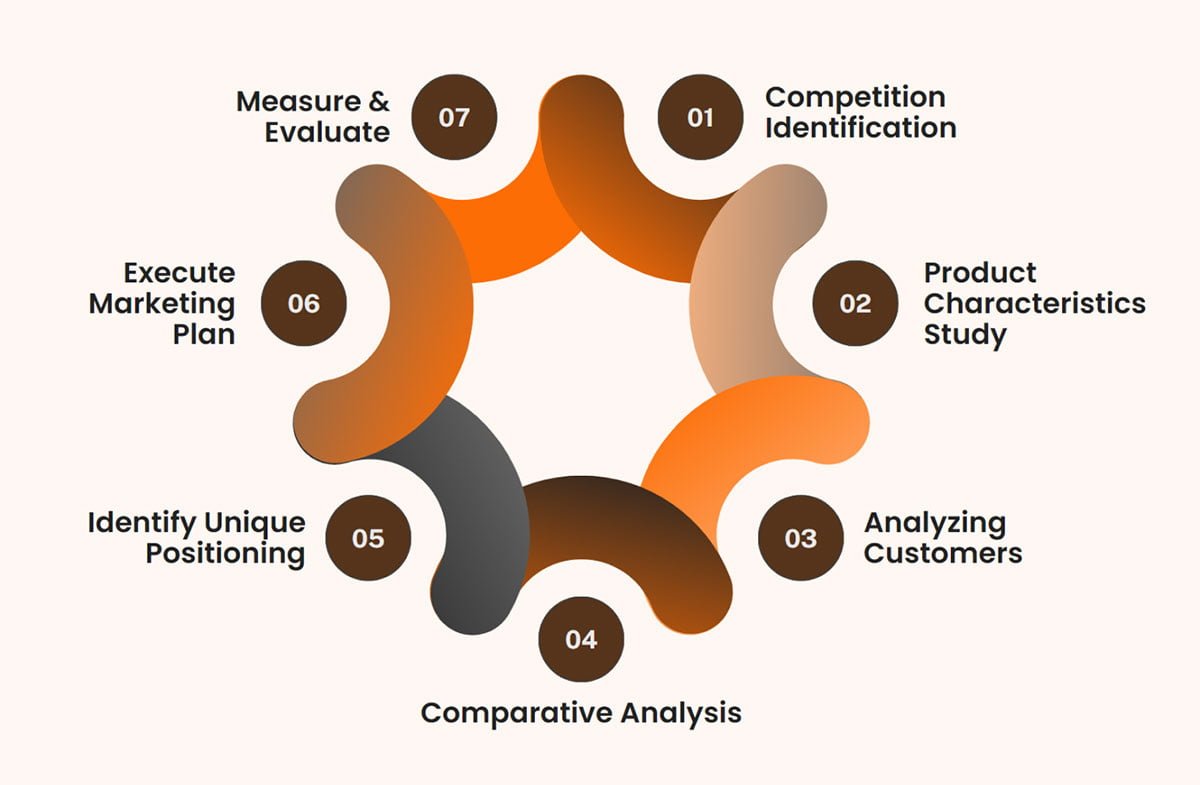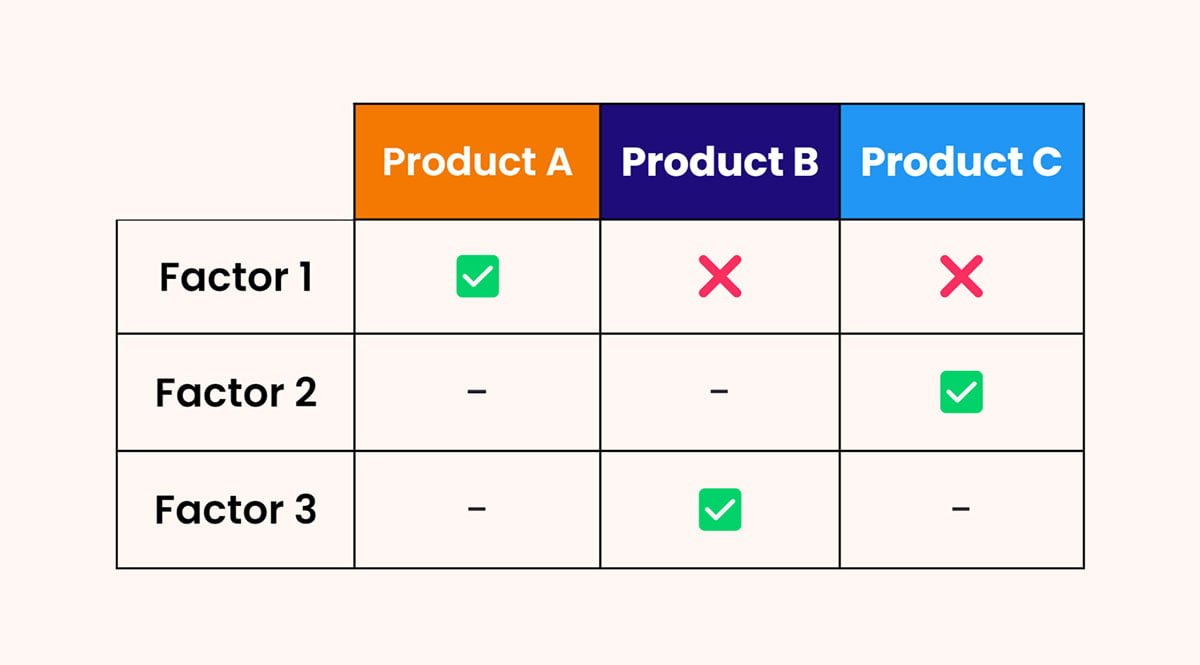What is Competitive Positioning in Marketing?

- Build Brand Loyalty: When your unique value proposition connects with customers, they’re more likely to remain loyal to your brand.
- Boosts Revenue: A strong competitive position attracts more customers, partners, and investors, ultimately driving revenue growth.
- Shapes Business Strategy: It serves as a guiding force for marketing, product development, and customer engagement, making sure all efforts are aligned with your overall business objectives.
Steps to Develop a Competitive Positioning Strategy
Step 1: Identify Your Goals

Step 2: Study Your Competitors

Step 3: Create a Competitor Overview

- Revenue and Market Share: Understanding the financial health and market presence of your competitors can provide insights into their competitive strengths.
- Product Features and Benefits: Analyze the features and benefits of competitors’ products or services, highlighting areas where they excel or fall short.
- Customer Perception: Gather feedback from customers to understand how competitors are perceived in the market. This can help you identify potential gaps or opportunities for differentiation.
Creating a detailed competitor overview helps you see the bigger picture and spot opportunities where your business can gain a competitive edge.
Step 4: Conduct Market Research

- Primary Research: This involves collecting firsthand information directly from customers or through direct observation. Methods include:
- Customer Interviews: Conduct one-on-one interviews with current or potential customers to gain insights into their preferences, pain points, and expectations.
- Online Surveys: Use surveys to gather quantitative data on customer satisfaction, buying behavior, and market trends.
- Focus Groups: Organize focus group discussions to obtain qualitative insights into customer attitudes and perceptions.
- Product Testing: Purchase and evaluate competitors’ products to understand their strengths and weaknesses.
- Secondary Research: This involves analyzing existing information from various sources. Methods include:
- Company Records: Review annual reports, financial statements, and other company documents.
- Industry Reports: Access reports from market research firms to understand broader industry trends and forecasts.
- Technological Developments: Stay updated on technological advancements that could impact your industry.
Step 5: Compare Product Features

- Price: Compare pricing strategies to determine if your product offers better value.
- Quality: Evaluate the quality of your product in terms of materials, durability, and performance.
- Ease of Use: Assess the user-friendliness of your product compared to competitors.
- Customer Support: Compare the level of customer support and service provided by each competitor.
- Unique Features: Highlight any unique features or benefits that set your product apart.
This comparison helps you identify areas where your product excels and areas that may need improvement.
Step 6: Analyze Marketing Strategies

- Social Media Presence: Examine competitors’ activity on social media platforms, including the type of content they post, their engagement levels, and their follower demographics.
- Website Copy: Review the messaging and positioning on competitors’ websites to understand their value propositions and key selling points.
- Paid Advertising: Investigate competitors’ use of paid advertising, such as Google Ads and social media ads. Assess the effectiveness of their campaigns by analyzing ad copy, visuals, and targeting criteria.
- Content Marketing: Evaluate the types of content competitors produce, such as blogs, videos, and infographics. Identify topics that resonate with their audience and the platforms they prioritize.
By looking at how your marketing compares to your competitors, you can see what’s working and where you might improve. Our Marketing Analytics service at Analyze Right helps you understand these details, so you can adjust your approach and stay ahead of the competition.
Step 7: Conduct a SWOT Analysis

- Strengths: What does your company do well? This could include product quality, customer service, brand reputation, or technological expertise.
- Weaknesses: What areas need improvement? This might include limited distribution channels, higher costs, or gaps in product features.
- Opportunities: What market trends or gaps can you exploit? Look for emerging customer needs, technological advancements, or regulatory changes.
- Threats: What external factors could negatively impact your business? Consider competitive pressures, economic downturns, or changing consumer preferences.
Visualize your SWOT analysis using a matrix to provide a clear snapshot of your competitive position. Use the insights from this analysis to inform your strategic decisions and prioritize initiatives.
Step 8: Use Perceptual Maps

To create a perceptual map:
- Identify Attributes: Choose two attributes that are most important to your customers. For example, price and quality.
- Plot Brands: Position your brand and competitors on the graph based on how well they perform on these attributes.
- Analyze Results: Look for gaps or clusters in the map that indicate opportunities for differentiation or areas where you need to improve.
Perceptual maps provide a visual representation of your competitive position and help you identify strategic opportunities.
Step 9: Find Your Niche

- Analyze Market Segments: Use your market research to identify segments that are underserved or overlooked by competitors.
- Evaluate Fit: Determine if your products or services align with the needs of this niche market. Take into account your capabilities, resources, and potential for growth.
- Develop Customized Strategies: Create marketing campaigns and product offerings that specifically address the needs and preferences of your niche customers.
Focusing on a niche market allows you to position your business as a leader in that segment, improving your competitive position.
Step 10: Develop a Timeline

- Set Clear Milestones: Define key milestones and deadlines for each stage of your strategy.
- Assign Responsibilities: Clearly outline who is responsible for each task and make sure everyone understands their roles.
- Track Progress: Regularly review progress and adjust your timeline as needed to stay on course.
- Communicate Effectively: Keep open communication with your team so that everyone stays informed and motivated.
A well-structured timeline keeps your strategy on track and ensures timely execution.
Example of a Competitive Marketing Position Report

Brews & Beans’ Competitive Marketing Position Report
- Target Market: Coffee enthusiasts aged 25-40 who appreciate premium, ethically-sourced coffee.
Product Comparison:
- Brews & Beans’ Product: Known for its high-quality, ethically-sourced beans, unique flavors, and excellent customer service. Priced competitively to offer great value.
- Competitors: Include brands like CoffeeMaster and BeanHaven. CoffeeMaster offers luxury coffee at higher prices, focusing on exclusive blends. BeanHaven provides budget-friendly options but with less emphasis on ethical sourcing and unique flavors.
- Market Share: Brews & Beans holds 15% of the market and is experiencing a growth rate of 8% annually. CoffeeMaster holds the largest market share at 25%, while BeanHaven follows with 20%.
SWOT Analysis:
- Strengths: Unique flavor profiles, strong brand reputation for ethical sourcing, exceptional customer service, and a loyal customer base.
- Weaknesses: Limited physical store presence, higher production costs, and smaller marketing budget compared to CoffeeMaster.
- Opportunities: Expanding online presence, introducing subscription services, and capitalizing on the trend towards sustainable and ethically-sourced products.
- Threats: Emerging competitors with lower prices, changing consumer preferences towards local roasters, and potential supply chain disruptions.
Perceptual Map:
- Attributes: Price (X-axis) and Quality (Y-axis).
- Positioning: Brews & Beans is positioned high on quality but needs to improve price competitiveness to capture more market share. CoffeeMaster is also high on quality but at a higher price, while BeanHaven is lower on both quality and price.
Strategic Recommendations:
- Improve Distribution: Expand distribution channels by partnering with major online retailers and local cafes in new markets to increase market reach.
- Focus on Sustainability: Develop and market eco-friendly packaging to attract environmentally conscious consumers. Implement sustainable practices in production and sourcing.
- Optimize Pricing: Explore cost-saving measures such as optimizing the supply chain and bulk purchasing to offer more competitive pricing without compromising quality. Introduce flexible payment plans to make high-end products more accessible.
Implementation Plan:
- Q1 2024: Launch an eco-friendly product line with a major marketing campaign focusing on sustainability.
- Q2 2024: Expand distribution channels in North America and Europe. Partner with popular online retailers and local cafes.
- Q3 2024: Collaborate with social media influencers and coffee bloggers to promote new products and engage with the target audience.
- Q4 2024: Review pricing strategies and implement cost-saving measures to improve competitiveness.
Why Regularly Update Your Competitive Analysis?

Key Actions for Regular Updates:
- Stay in Tune with Industry Trends: Keep your finger on the pulse of your industry’s latest developments, from new technologies to changing regulations.
- Watch Your Competitors Closely: Stay alert to your competitors’ new moves—whether it’s a product launch, a marketing campaign, or customer feedback—so you’re never caught off guard.
- Improve Your Strategy: Use new insights to adjust your positioning, making sure it continues to connect with your audience and works effectively.
Conclusion
At Analyze Right, we’re here to help. With our market insights and personalized strategies, we’ll support your business in finding its strength and succeeding, no matter the competition.


